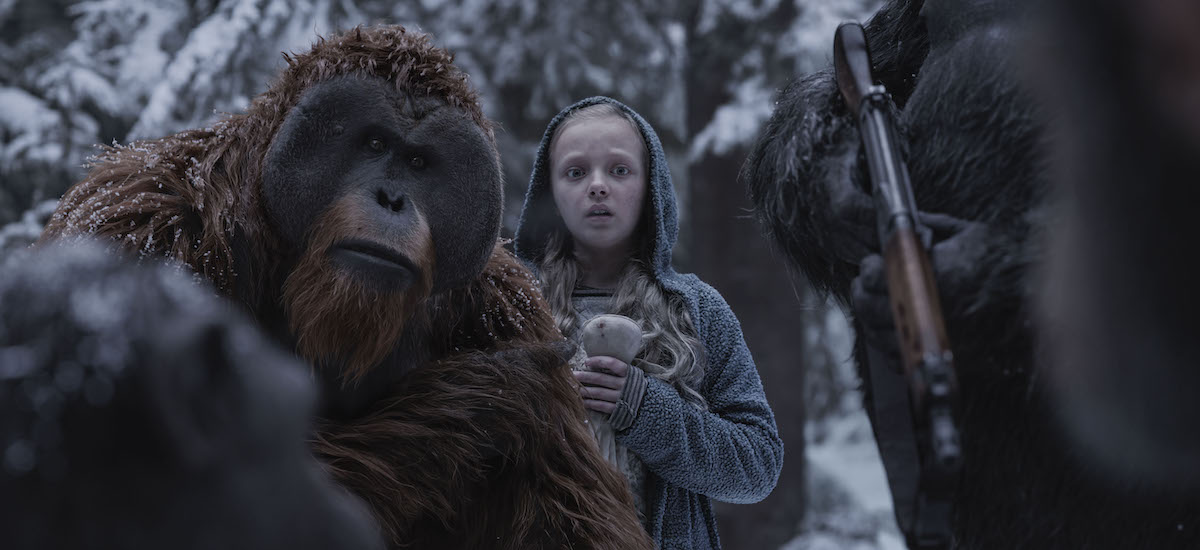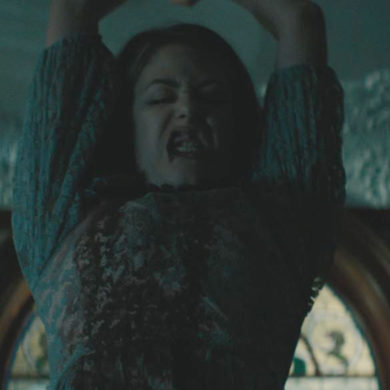While bad-mouthing the CGI recreations of Grand Moff Tarkin (Peter Cushing) and Princess Leia (Carrie Fisher) in Rogue One, I mentioned that digital artists have not quite gotten the eyes to convincingly depict actual human beings. Why then, have the three modern Planet of the Apes movies (Rise, Dawn, and now War) been able to do it so well with chimpanzees, orangutans and gorillas?
In my 2014 review of Dawn of the Planet of the Apes, I raved about the realistic ape effects, stating that they were the strength of the movie. With War for the Planet of the Apes, it seems redundant to say the same thing. Luckily, the overall experience transcends only this component. I liked it better than Dawn, but I’m not certain it’s my favorite of the three.
War begins five years after Dawn, meaning it’s 15 years after Rise and the events that set the evolution of apes in motion. That was when a chimp named “Caesar” was enhanced during experiments to cure Alzheimer’s. For the first time in the series, though, War introduces the flip side of the coin: the devolution of man. The disease that killed much of the world’s population now begins to affect the survivors.
Therefore, War for the Planet of the Apes acts as the final chapter in a trilogy about one ape, Caesar, as well as a big set-up for a planet of apes with which we’re familiar from the original series of movies. It wouldn’t be incorrect to say that this trilogy equates to one movie from that series, Conquest of the Planet of the Apes (1972), in that collectively they could be called, “Origin of the Planet of the Apes.”
The titular “war” ultimately takes place between the troops of Woody Harrelson’s crazed colonel and the shrewdness (look it up) of Caesar’s apes. Prior to that, though, it’s a more personal battle between the colonel and Caesar when the former kills the latter’s wife and son in a failed attempt to assassinate the ape leader himself. Caesar again struggles between head and heart, between doing what’s “right” and seeking revenge. The bonobo (look it up), Koba, set the events of War in motion during Dawn of the Planet of the Apes and his spirit lingers throughout, haunting Caesar in his dreams. Initially engaging humans only for self-defense, Caesar doubts the tactic and struggles with the fact that Koba may have been right to take an offensive approach to survival.
The bonobo (look it up), Koba, set the events of War in motion during Dawn of the Planet of the Apes and his spirit lingers throughout, haunting Caesar in his dreams. Initially engaging humans only for self-defense, Caesar doubts the tactic and struggles with the fact that Koba may have been right to take an offensive approach to survival.
Koba’s followers still oppose Caesar and have taken to assisting Harrelson and his humans, even though they’re treated as “donkeys” that wait on them hand and foot. This makes the simple ape vs. human struggle more complex as apes sometimes fight apes. Even more complex is the revelation that the army of humans approaching from the north may be coming to stop Harrelson, not Caesar.
The development and execution of these ideas is where War for the Planet of the Apes shines. Unfortunately, there’s a big chunk of the movie that causes it to drag. When Caesar’s apes are captured and used as slave labor to build a defensive wall for the colonel, Caesar is also imprisoned. Scenes of his punishment and related wordy encounters with the colonel become repetitive.
I suppose this sequence of events is meant to force Caesar to his lowest point before he finds enough inner strength to rally the apes, like a simian Rocky. The progression is protracted, though, while not quite delivering a satisfying fall and rise of the underdog hero. Also, the final event concluding the movie feels like a second ending. As it began, I thought, “You’re kidding. Now this?” It explains a big step in ape evolution mythology, but almost too tidily. I really thought the movie was headed somewhere else and hoped for something akin to Beneath the Planet of the Apes (1970) which would have provided a dark twist while still setting up a new cycle of stories.
Also, the final event concluding the movie feels like a second ending. As it began, I thought, “You’re kidding. Now this?” It explains a big step in ape evolution mythology, but almost too tidily. I really thought the movie was headed somewhere else and hoped for something akin to Beneath the Planet of the Apes (1970) which would have provided a dark twist while still setting up a new cycle of stories.
Speaking of previous ape movies, War delivers several images and concepts to make a fan smile. The structures standing outside the colonel’s fortress, to which prisoners are tied, resemble those in the Forbidden Zone of the original Planet of the Apes (1968) and Beneath. Also, a young girl (Amiah Miller) could very well grow up to be a familiar and favorite character.
In a way, War for the Planet of the Apes squanders an opportunity to align with the original movie series, not only with its ending, but also by dropping a plot point introduced in Rise of the Planet of the Apes (2011) that was mentioned a second time in Dawn. It would have been a nod to the original and just a clever plot twist in its own right.
Then again, this modern Planet of the Apes trilogy has never been about plot points and developing a familiar science fiction mythology. It’s been the story of one ape character, acting as a larger metaphor for the rise, dawn and war of the entire species of man, rather than a sensational story for the sake of pure entertainment. It certainly helps, though, that this story has been entertaining.
War for the Planet of the Apes is very entertaining. Don’t let the nitpicking of an Apes purist deter you from seeing it. It’s an exciting and satisfying conclusion of, and resolution for, Caesar’s story. I wouldn’t be surprised if audiences applaud and perhaps shed a tear. It’s easily the best big-budget blockbuster movie (so far) of an otherwise lackluster summer.



